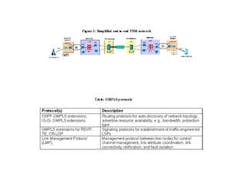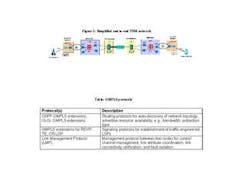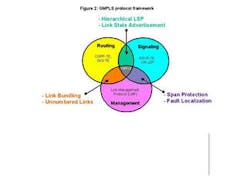Challenges and opportunities of using GMPLS in TDM networks
By ROBERT HAIM
Polaris Networks Inc.
Service providers are continually evaluating new technologies to satisfy growing demand for higher bandwidth services. The deployment of packet- and cell-based networks promises to meet these needs while offering to increase network efficiencies to an extent that rivals traditional circuit-switched (TDM-based) voice networks. However, in reality, today's service provider revenue is still largely drawn from voice traffic carried over SONET networks. In fact, most services (voice, video, data) travel on TDM network segments.
While TDM transport networks are the underlying infrastructure, service providers are challenged by their rigidity, given the configuration, provisioning and management of TDM-based circuits if often resource-intensive, expensive and problematic. The speed of services provisioning in TDM networks is also reduced by the number of network elements required. Today, overlays of different optical transport equipment, such as add/drop multiplexers (ADMs), and switching equipment, must be managed and scaled separately.
To overcome the challenges of managing TDM networks, various standards bodies, including the International Engineering Task Force (IETF) and the Optical Internetworking Forum (OIF), have proposed new approaches for managing networks and their resources more efficiently. These proposals essentially move the intelligence of network management systems into the network itself.
Enter GMPLS
At the forefront of these proposals is the concept of generalized multi-protocol label switching (GMPLS). The GMPLS protocol suite, evolving from MPLS, addresses the signaling and routing protocols intended to automate the processes required for the network to manage itself. MPLS was originally designed to enhance the forwarding performance and traffic engineering ability of IP networks, enabling convergence of ATM and IP networks by establishing end-to-end paths, known as label switched paths (LSPs). GMPLS takes those same mechanisms and extends them to other types of switching media.
GMPLS encompasses not only packet switching, but also TDM-, wavelength-, and spatial-switching. GMPLS seeks to manage complexity, simplify traffic-engineering, and reduce network bottlenecks. Importantly, the ongoing efforts to standardize GMPLS will tailor the protocol specifications to provide the basis for an open and interoperable next-generation optical network that can support all service types.
Current TDM networks
Shown in Figure 1, user traffic travels through multiple points-of-presence (PoPs) and two local central offices (COs). To set up an end-to-end logical path connection between two customer locations, the operators--a local access provider, the incumbent local exchange carrier (ILEC), and the interexchange carrier (IXC)--must notify each other to coordinate, administer and execute the process. The entire process is complex, time-consuming and labor intensive.
Before the setup, the operator of each network segment conduct a feasibility request and reserve the bandwidth needed for the new service. This process requires significant coordination via phone, fax or email. On completing this, the operators identify an end-to-end path. Similarly a back up path may also be required..
Next, provisioning of each piece of equipment along the identified path takes place. For example, at the local office, the operator must individually configure the access platforms. Even with the latest network management tools, these tasks may take hours, or even days, to complete.
At the first metro hub, the operator must provision its ADMs and digital crossconnect system (DCS) by carving out an STS-x or other denominations to transport user traffic. This step is repeated at each segment until the local CO is finished with its provisioning. Once the path has been provisioned, it must be tested for correct operation.
Today's manual provisioning requires high operational expenditures, taking at least one week on average per customer. This essentially is an opportunity cost in lost time and man-hours.
Signaling and routing protocols
To overcome manual provisioning, a suite of signaling and routing protocols can be employed to automate network operation. Some vendors have opted to implement proprietary protocols for this purpose. However, non-standard protocols only localize efficiency for specific equipment and equipment types. In multi-carrier, multi-vendor, multi-system network architectures, this strategy will not work. Therefore, a set of standardized routing and signaling protocols is necessary to achieve true provisioning autonomy - GMPLS. A brief description of GMPLS protocols and their relative positions to each other is shown in Table 1.
TDM requirements for GMPLS
GMPLS provides two basic functions:
1) It automates the establishment of an end-to-end LSP for a variety of switching domains (packet, TDM, lambda, fiber).
2) LSP are established at operator-defined service levels. Specifically, for TDM circuits, the QoS levels are deterministic and constant, requiring a high degree of reliability. Using GMPLS, the process mentioned in the previous section effectively collapses into two sets of operations- identifying the LSP end points and service creation.
There are additional factors required to successfully automate the provisioning of connections in a TDM network. For example, to scale the network, the automation scheme must segment, given it is quite probable that an LSP traverses multiple networks belonging to different operators. These operators are likely to have agreement levels among themselves and also, may not want to share their network topologies with other operators.
Therefore, to accommodate establishment of an LSP across inter-operator network segments, the Optical Internetworking Forum (OIF) has designed a signaling protocol, User Network Interface (UNI) 1.0. to provide an "overlay" model. In this model, separate control planes run in the two networks with minimal interaction between them. The network can be segmented into several domains, running UNI 1.0 between each two segments to further ease network management.
The TDM network must also quickly process and resolve faults. The introduction of intelligent fault management requires three basic steps - detection, localization, and resolution. For TDM networks, fault detection at the transport level is provided via parameters that include signal degrade, signal failure, etc. The other steps are provided via the Link Management Protocol (LMP) that uses a single message to carry out fault-localization and determine where a fault has occurred. Once localized, the fault is resolved by pre-allocated, protective resources (paths or links) used for the specific connection.
Since TDM services require the highest reliability, SONET protection schemes, that provide sub-50 ms restoration, are used to address network protection. Typically 1+1 and M:N protection schemes are used. For 1+1 protection, the backup path simultaneously transports a duplicate of the primary path, nailing up twice as much bandwidth, but offering fast recovery during failure. In the M:N case, the backup paths only become active once failure has occurred. The M:N scheme has two special cases, 1:N and 1:1, whereby only one dedicated backup path is used to support N or 1 primary path, respectively. The 1+1 scheme is more common for TDM networks.
GMPLS provides both protection of failed channel (or link) between two adjacent nodes (span protection) as well as end-to-end protection (path protection). It supports both 1+1 and M:N protection schemes in its extensions for the routing and signaling protocols - providing these protection schemes by establishing secondary paths through the network and signals a change from the failed primary path to the secondary path.
Specifically, the open-shortest-path-first (OSPF) and intermediate system-to-intermediate system (IS-IS) extensions for GMPLS advertise the "link protection type" parameter to include span protection while the route is being computed. After the route is computed, signaling for the backup paths is carried out via Resource Reservation Protocol-Traffic Engineering (RSVP-TE) or Constraint Routed-Label Distribution Protocol (CR-LDP).
GMPLS provides pre-configured, pre-allocated backup paths for protection of the primary paths. The backup (secondary) path is used for fast switchover in case of failure on the primary path. Of particular note, the secondary path does not need to be idle. It can be used to transport "best effort" traffic. In case of a switchover, the low priority traffic can be pre-empted, and additional revenues from an otherwise idle resource can be realized.
Maintain and automate
SONET-based TDM networks rely on bi-directional "hop-by-hop" paths for protection switching [2-wire and 4-wire bi-directional line-switched ring (BLSR)]. SONET connections between two nodes are paired in existing SONET equipment and carry control information in-band using overhead bytes. Therefore, while it is possible to set up two distinct unidirectional paths, an expedited method to set up a bi-directional path becomes important for SONET. GMPLS provides this setup with a single set of connection-establishment messages, as long as both directions of the path share the same requirements regarding protection and restoration.
When GMPLS establishes an end-to-end LSP, it assumes that the network trunks (in the computed route) have been configured to carry the load LSP. There is currently no mechanism in GMPLS to automate the provisioning of the trunks. The operator provisions trunks statically through the network management system. Only after the trunk is provisioned can traffic flow through the network.
Recently, a new approach to automating the provisioning of trunks has been offered in the IETF. Called "dynamic trunking," this approach proposes to provision the trunks to carry the required payload as the LSP is being configured (more information is available from the IETF at http://search.ietf.org/internet-drafts/draft-cheng-gmpls-dynamic-trunking-00.txt). Dynamically created trunks, which make the end-to-end provisioning of an LSP truly a "point-and- click" operation, require some extensions to have all the features and protection characteristics of statically configured trunks.
Interoperability issues
The co-existence of packet, cell and TDM traffic will necessitate a scheme that allows provisioning across dissimilar network types. The LSP hierarchy feature of GMPLS enables this, allowing for an eventual migration of TDM to all-IP networks. Extensions in the routing and signaling protocols, such as OSPF and RSVP-TE, provide the ability to establish end-to-end LSPs that can span several network types. Within each network, an LSP can be established and transported within the LSP of another network type. Therefore, aggregation of multiple traffic flows can be achieved in a hierarchical fashion to scale network infrastructure.
For example, a packet-based LSP, established within an IP network segment, can traverse a TDM network via a TDM LSP created across the TDM segment. This capability allows a methodical infrastructure build-up by a carrier whose goals include migration from an all-TDM network to a mixed TDM/IP and, finally, to an all-IP network.
Summary
Improved efficiency and economics is ultimately the benchmark of a successful new technology. Although issues such as multi-vendor interoperability and interfacing to the operation support system (OSS), must still be addressed, GMPLS promises to substantially improve today's network operations by reducing provisioning times down to minutes and seconds from today's days and weeks. GMPLS also provides a clear path for TDM-based network operators to migrate towards supporting other service types (cell, packet). This will service providers to diversiy their services and revenue opportunities without disrupting the legacy base.
Robert Haim is senior manager of product marketing at Polaris Networks (www.polarisnetworks.com), headquartered in San Jose.


